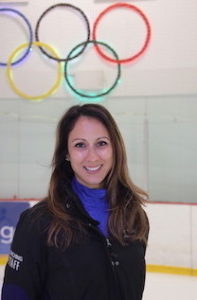3 Visualization Techniques for Figure Skaters to Reach Optimal Performance
by Stephanie Siclari
The discussion around mental health is becoming more of an everyday conversation as elite athletes are speaking out on the pressures they face and how they handle the stress that comes with being a top athlete.
As figure skaters, we are asked to perform our best. We train day in and day out preparing ourselves for the competition, the test or exhibition. Many of us watch our nutrition and sleep habits to ensure our bodies are at an optimal performance level. Yet, how many of us pay mind to the inner dialogue happening within our own heads?
One component of optimal performance is mentally preparing ourselves for our competition, test, or even practice. No matter our skating level, having a strong mental composition can be the difference between nailing our program or succumbing to the nerves of competition day. After all, one of the old adages is that sport is 90% mental and 10% physical. Yet, as figure skaters, we often spend 100% of our time working on our physical strengths and forget about working our minds to match.
Visualization for Optimal Performance
One of the most effective strategies in mentally preparing ourselves for the outcome we want to achieve is through visualization. Generally speaking, visualization is guided imagery and visualizing is the process of creating a mental image or intention of what you want to happen in real life.*
Sit in a comfortable position or lie down — whichever feels most comfortable for you. Make sure you are free of any distractions, such as your phone, television, or even family or friends. Now let’s get visual!
Three Tips for Optimal Visualization
- Be Realistic: Imagine yourself at the rink and visualize landing your Axel. Where on the ice do you normally jump? Who is around? Are you in a lesson or practice? What are you wearing? What music is playing? Fully immerse yourself in the exercise. The more realistic you can make the experience, the better (for optimal results). You skate around the rink, set up, take off and land the jump just as you would on the ice. If you are visualizing a competition, imagine you are stepping onto the ice for your performance. What do you see? You take your starting position, and your music starts. Go through your program from start to finish imaging each element as it comes. It may be helpful to play your music so you can “skate your program in your mind.”
View my guided visualization video.
- Judgment Free: In “real life,” we do not always land 10 out of 10 jumps, right? If you miss your element while visualizing, let it go and try again (just as on the ice). Like any muscle, training your mind takes practice. The more you practice visualizing, the easier it becomes. However, there are still instances where it is not perfect. This is one of the many benefits of practicing visualization and mindfulness. Let go of what just happened in your imagination and try again, free of judgment of yourself. Take a deep breath, shake it off and try it again. Remember what went well and what did not, which leads us to step 3.
- Reflection: Keeping a written journal is a great way to log your progress. This also helps you track what worked and what didn’t. Maybe you tried your jump in a different spot on the ice than you normally would jump, and it worked. Or perhaps you “felt” the nerves of competition during the exercise. Write down how you felt and use that to your advantage on actual competition day. Of course, consult with your coach before making any changes to your routine.
*Source: Team USA
Resources:
- Coach Stephanie’s Downloadable Visualization Guide
- Coach Stephanie’s Jump Visualization Exercise on YouTube
- “The Mindful Athlete” by George Mumford
Stephanie Siclari has been providing figure skating and power hockey skating instruction for all ages and levels for 15 years. She has worked with skaters from across the globe, who have competed at national and international competitions as well as the U.S. Figure Skating World Synchronized Skating Championships. She is a former senior ladies competitor and two-time U.S. Synchronized Skating champion and Team USA member (Miami University, Ohio, collegiate and senior teams). She is the creator of SKATERFIT, an off- and on-ice training program designed to help skaters build confidence and physical and mental strength while providing a fun platform to achieve their goals. For more information, please visit coachstephaniesiclari.com. You can also visit her YouTubechannel for additional exercises.
Disclaimer: Stephanie Siclari is not a licensed therapist and makes no claim that the visualization techniques mentioned here are a direct way to treat mental health. If you are feeling stressed, anxious and/or or have suicidal thoughts, please seek professional help.

 MY COACH ROCKS
MY COACH ROCKS TEAMS IN SYNC
TEAMS IN SYNC EXPRESS YOURSELF
EXPRESS YOURSELF FOCUS ON ARCHIVES
FOCUS ON ARCHIVES COMPETITORS’ CORNER
COMPETITORS’ CORNER NEWS & NOTES
NEWS & NOTES









